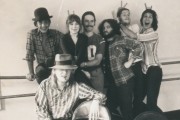 I’m a sucker for movies about making movies because film is the only medium that is so successful at being self-referential in that way. There aren’t many great songs about the writing of a song, many novels about writing a novel, or paintings about painting a painting. Part of that is because the film industry has always been filled with colorful personalities, and part of it is because Hollywood loves movies about how great Hollywood is (c’mon, why do you think Argo won so many awards? Sure, it was good, but Hollywood loves nothing more than a movie that is all about how Hollywood saved the day!)
I’m a sucker for movies about making movies because film is the only medium that is so successful at being self-referential in that way. There aren’t many great songs about the writing of a song, many novels about writing a novel, or paintings about painting a painting. Part of that is because the film industry has always been filled with colorful personalities, and part of it is because Hollywood loves movies about how great Hollywood is (c’mon, why do you think Argo won so many awards? Sure, it was good, but Hollywood loves nothing more than a movie that is all about how Hollywood saved the day!)
As for colorful personalities in the film industry, perhaps no person stands taller than Walt Disney. There is nobody in entertainment whose name and life’s work are as recognizable to our culture than Disney, even nearly fifty years after his death, and one of his studio’s most beloved films is Mary Poppins. As the story goes, Disney tried to convince Mary Poppins author P.L. Travers to let him make a Mary Poppins movie for decades because he promised his daughters that he would. However, she outright refused to even hear him out. It isn’t until 1961, when Travers hadn’t published a book in nearly a decade and was on shaky ground financially, that she finally agrees to meet with Disney, who offers her final approval on the script if she would just come to California to meet with him and his production team.
From the moment P.L. Travers… excuse me, Ms. Travers, is introduced in the film, it’s impossible to imagine that such a dour woman wrote the source material for one of the most beloved family films. Portrayed by Emma Thompson, Travers is incredibly cold, easily aggravated, and has little use or interest for anyone who doesn’t agree with her. In other words, she is the portrait of English stiffness. On the other hand, Walt Disney (Tom Hanks) has a personality as warm as the weather in Southern California. As dozens (hundreds?) of movies have shown us, there is inherent comedy to putting two opposites together. However, the true cleverness of the film is that it doesn’t focus much on these differences and instead focuses on the inherent struggle between the unstoppable force (Disney) against the immovable object (Travers). The conflict isn’t that they’re so different because as the film eventually shows us how similar they really are.
Along with amusing scenes of Travers working with (or, really, working against) the Mary Poppins production team — screenwriter Don DaGradi (Bradley Whitford), and songwriters Robert (B.J. Novak) and Richard (Jason Schwartzman) Sherman, the film’s second narrative is made up of flashbacks of Travers’ childhood memories of her father, Travers Goff (Colin Farrell). Father Goff has nothing but deep affection for his daughters and entertains their whimsical fantasies, but that hides his personal troubles that have his wife, Margaret (Ruth Wilson) frequently at her wit’s end. Before seeing this film, audiences would likely be surprised by the title referencing the father in Mary Poppins instead of the story’s more colorful characters (particularly, of course, Mary herself). After seeing this, it will likely be impossible to ever watch Mary Poppins without realizing just how important father figures were to Travers and why Mary Poppins was so personal to her.
Though some actors go their entire careers without giving audiences one scene of greatness, Hanks has pulled the incredibly rare feat of giving audiences two outstandingly acted scenes in both films he appeared in this year. The first is the incredibly powerful scene in which his character is examined by a doctor at the end of Captain Phillips as he emotionally breaks down, and the second is in this film when Disney finally unlocks Travers’ attachment to Poppins and explains to her why he can relate to her difficult childhood. Hanks doesn’t particularly look like Walt Disney, but it’s hard to see him as anyone other than Walt Disney himself in this scene. After watching this scene, I cannot think of another actor who could have portrayed Disney other than Hanks.
Of course, Thompson is even more important to this film than Hanks, and as expected she equals and perhaps surpasses his performance. The way screenwriters Kelly Marcel and Sue Smith and director John Lee Hancock slowly peel back the layers of Travers’ childhood gradually clues the audience into why she is so strict about the Mary Poppins adaptation is reflected in Thompson’s portrayal of Travers, which comes to a conclusion with a remarkable scene of Travers watching the film (sorry, spoiler alert: Travers finally does agree to let Disney make Mary Poppins into a film. I’m sure you’re not surprised). The emotional turmoil — both because of her personal pain and the fact that she really hates the film (and Travers hated it for the rest of her life) — on Thompson’s face is mesmerizing, albeit misleading (she was not crying tears of joy in real life, though the film definitely tries to cloud that). I didn’t think the previously mentioned Hanks scene could be topped, but Thompson does it.
While Thompson and Hanks loom large, Farrell again proves he can be a wonderful dramatic actor when the script calls for it, and Paul Giamatti is equally great as Travers’ limo driver while she stays in Los Angeles. Kathy Baker and Melanie Paxson also are great as a pair of trusted voices in the Disney inner circle. But I’m most impressed with Hancock, who has seemed to have finally gotten a handle on the sentimental type of filmmaking he has previously done as a director. In a way it’s easy to provoke an emotional response from an audience with vintage Disney imagery, but Hancock also makes no attempt to hide how overbearing the Disney brand can be to an outsider. I thought Hancock’s The Blind Side was good but laid it on too thick, so I’m utterly impressed that Hancock was able to make a film about Walt Disney for Disney and still poke holes in the glittering facade that the Disney brand often can be.
Hanock could have easily made a much less challenging, more crowd-pleasing film with this material, but both Hancock and Disney (the company) should be commended for not doing so, even if as a whole it isn’t as true-to-life as the ending scene suggests. Nonetheless, I think those going into Saving Mr. Banks might expect a fun film with Tom Hanks doing a Walt Disney impression for two hours. I hope many are pleasantly surprised to see that it’s much more than that, because, as the PG-13 rating suggests, this isn’t a zip-a-dee-doo-dah trip to the Magic Kingdom to worship at the altar of Walt. Thank goodness it isn’t.
Rating: Though often awash in sentimentality, it’s hard to feel anything but affection for such a charming film and marvel at the risks it actually takes (8.5/10)















Recent Comments